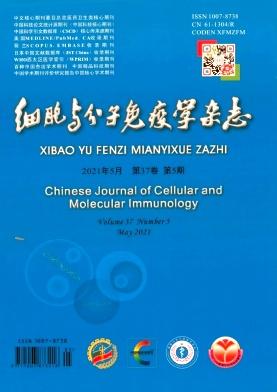[miR-207靶向自噬相关蛋白LAMP2调控巨噬-结核分枝杆菌相互作用机制]。
摘要
miR-207已被确定在自然杀伤(NK)细胞外泌体中表达,在疾病进展中起作用;然而,到目前为止,还没有研究明确地将miR-207与结核病联系起来。方法采用生物信息学方法进行预测,然后采用双荧光素酶报告基因检测来确定miR-207是否靶向溶酶体相关膜蛋白2 (LAMP2)。采用脂质体转染法将实验分为四组(OP-LAMP2组:共转染miR-207模拟物和LAMP2过表达质粒;EP组:用模拟NC和空载质粒共转染;siLAMP2组:转染siLAMP2;siLAMP2-NC组:转染siLAMP2-NC)。采用h37ra感染的Ana-1细胞建立结核感染模型。通过结核菌落形成单位计数评估LAMP2对细胞内分枝杆菌负荷和细胞外残余分枝杆菌清除的影响。流式细胞术检测总凋亡率。采用实时荧光定量PCR检测LAMP2、凋亡基因、焦亡基因和自噬基因的相对表达量。Western blot检测LAMP2蛋白、凋亡蛋白、焦亡蛋白和自噬蛋白的相对表达。结果双荧光素酶报告基因检测显示,LAMP2与miR-207之间存在靶向关系。通过实时荧光定量PCR、Western blot统计分析和显微观察成功构建转染模型。显微镜下成功建立感染模型。菌落形成单位计数显示,OP-LAMP2组的菌落数量低于EP组,而siLAMP2组的菌落数量高于siLAMP2- nc组。流式细胞术检测结果显示,OP-LAMP2组细胞凋亡总量低于EP组,siLAMP2组细胞凋亡总量高于siLAMP2- nc组。实时荧光定量PCR和Western blot分析结果显示,OP-LAMP2组的细胞凋亡和焦亡相关蛋白及基因的相对表达量低于EP组,siLAMP2组的细胞凋亡和焦亡相关蛋白及基因的相对表达量高于siLAMP2- nc组。实时荧光定量PCR检测自噬正调控基因微管相关蛋白1轻链3(LC3)和Beclin1在OP-LAMP2组的相对表达量高于EP组,siLAMP2组的相对表达量低于siLAMP2- nc组,而自噬负调控基因的相对表达量与自噬正调控基因的相对表达量相反。自噬相关蛋白的相对表达与自噬基因的变化趋势一致。结论miR-207通过靶向自噬相关蛋白LAMP2,增强巨噬细胞凋亡,抑制自噬,促进结核分枝杆菌存活,为结核病的治疗提供了新的方向。Objectives miR-207 has been identified as being expressed in natural killer (NK) cell exosomes that play a role in disease progression; however, to date, there are no studies specifically linking miR-207 to tuberculosis (TB). Methods Bioinformatics methods employed for prediction, followed by a dual luciferase reporter assay to determine whether lysosome-associated membrane protein 2 (LAMP2) is targeted by miR-207. The experiments were divided into four groups using the liposome transfection method (OP-LAMP2 group: co-transfected with miR-207 mimics and LAMP2 overexpression plasmid; EP group: co-transfected with mimics NC and null-loaded plasmid; siLAMP2 group: transfected with siLAMP2; and siLAMP2-NC group: transfected with siLAMP2-NC). TB infection was modeled using H37Ra-infected Ana-1 cells. The impact of LAMP2 on intracellular mycobacterial load and clearance of extracellular residual mycobacteria were assessed by tuberculosis colony-forming unit counting. Flow cytometry was used to assess the total apoptosis rate. Real-time fluorescent quantitative PCR was conducted to determine the relative expression of LAMP2, apoptosis genes, pyroptosis genes, and autophagy genes. Western blot analysis was performed to measure the relative expression of LAMP2 proteins, apoptosis proteins, pyroptosis proteins, and autophagy proteins. Results Dual luciferase reporter assay test showed that there was a targeting relationship between LAMP2 and miR-207. The transfection model was successfully constructed under real-time fluorescent quantitative PCR and Western blot statistical analysis, and microscopic observation. The infection model was successfully established under microscopic observation. Colony forming unit counting revealed that the number of colonies in the OP-LAMP2 group was lower than that in the EP group, while the number of colonies in the siLAMP2 group was higher than that in the siLAMP2-NC group. Flow cytometry assay revealed that the total apoptosis in OP-LAMP2 group was lower than that in EP group, and the total apoptosis in siLAMP2 group was higher than that in siLAMP2-NC group. Real-time fluorescence quantitative PCR and Western blot analysis revealed that the relative expression of apoptosis and pyroptosis-related proteins and genes in the control group was lower in the OP-LAMP2 group compared to the EP group, and higher in the siLAMP2 group compared to the siLAMP2-NC group. Real-time fluorescence quantitative PCR detected that the relative expression of autophagy positively regulated genes Microtubule-associated protein 1 light chain 3(LC3)and Beclin1 in the OP-LAMP2 group was higher in the OP-LAMP2 group compared to the EP group, and lower in the siLAMP2 group compared to the siLAMP2-NC group, while the relative expression of negatively regulated autophagy genes followed the opposite trend to that of autophagy positively regulated genes. The relative expression of autophagy-related proteins was consistent with the trend of autophagy genes. Conclusions miR-207 enhances macrophage apoptosis, cellular pyroptosis and inhibits autophagy, promoting survival of Mycobacterium tuberculosis by targeting the autophagy-related protein LAMP2, thus offering a novel therapeutic direction for tuberculosis.

 求助内容:
求助内容: 应助结果提醒方式:
应助结果提醒方式:


